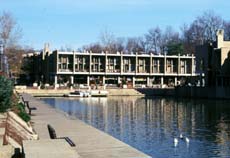index
Habraken on homogeneity
A visually or architecturally homogeneous area may be a complex place lived very differently and belonging to many different networks at once. Loyalty to an area and its style can stem from diversity as well as homogeneity.
Inhabitants of the local -- and all inhabitation is local -- function in networks, too. A single person may constitute a node in more than one active network (religion, hobby, work, relatives). This may not only reduce the time that person actually spends at home, but also divert her attention from local affairs when there. . . . Moreover, my neighbor and I may find no overlap comparing the networks into which we are locked. We may share neither religion, nor race, nor work, nor hobbies. If sociocultural coherence is low, what does that mean for the environment we share? Must our homes express such differences as true nodes in different networks? Perhaps, on the contrary, formal coherence may be even more important because environmental preference is what brings us together. Just because we can easily relocate, sharing environmental coherence may be more important than ever. But then again, such coherence does not signify shared experience and need not be rooted in local formal tradition. Our common preference may be for an imported or recently (designer) invented environment. Habraken 1999, 31

